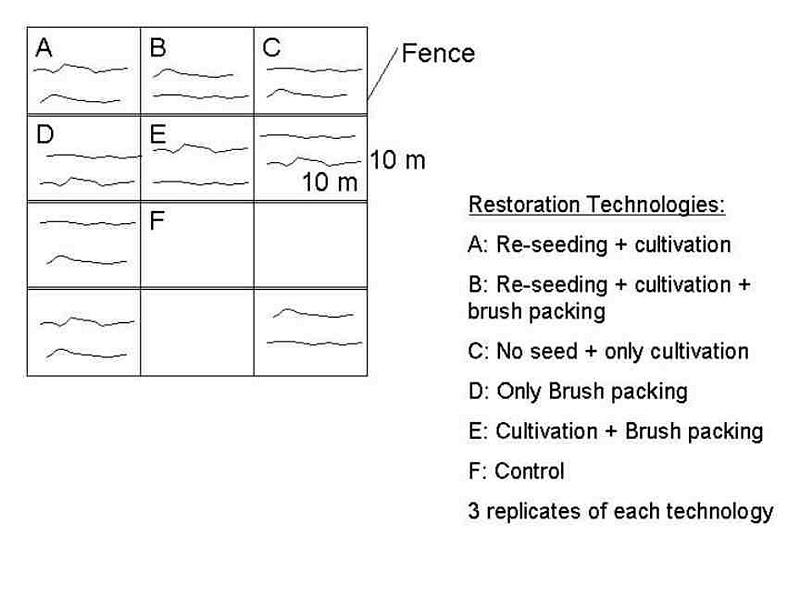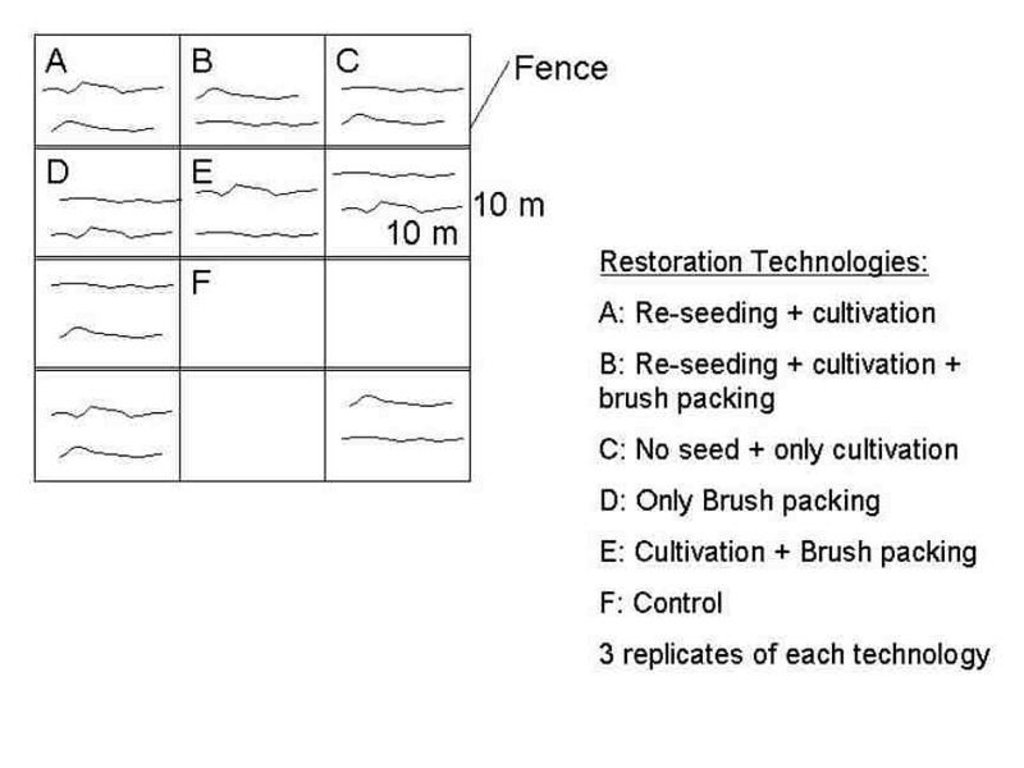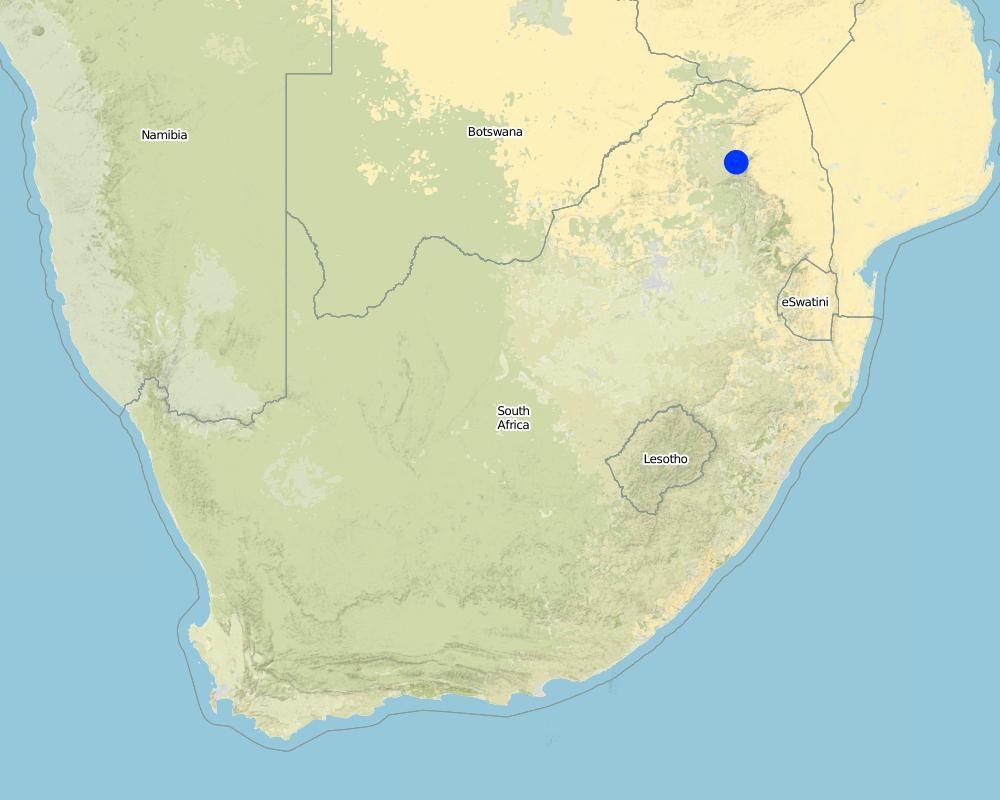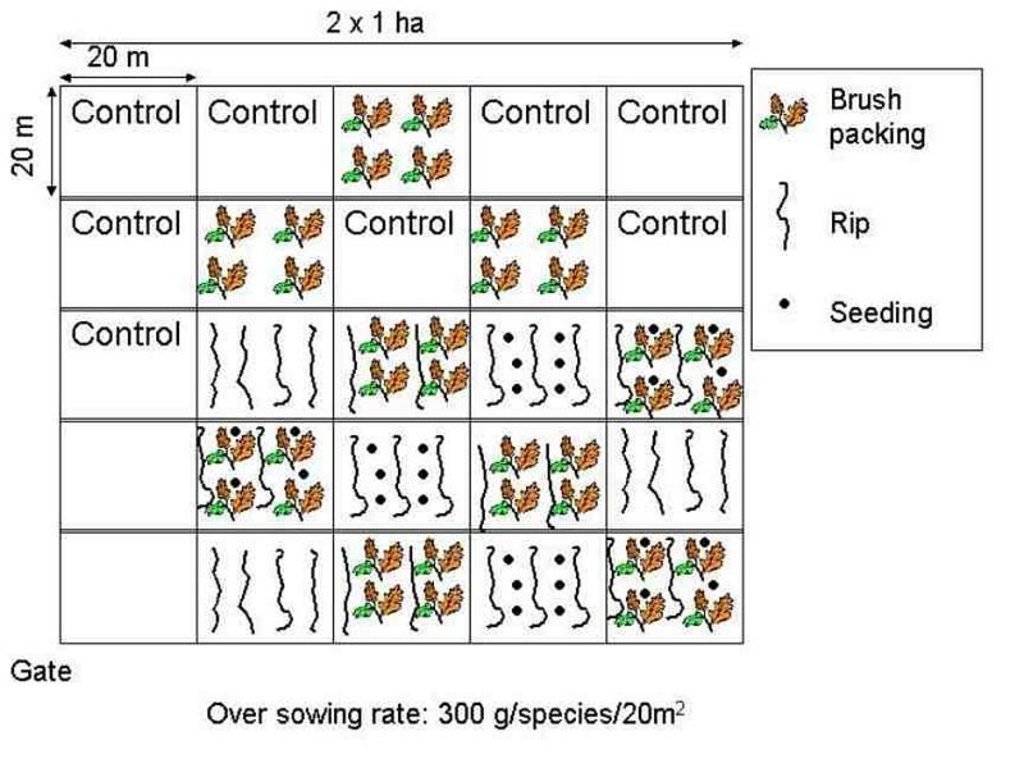Revegetation and re-seeding [南非]
- 创建:
- 更新:
- 编制者: Klaus Kellner
- 编辑者: –
- 审查者: David Streiff, Alexandra Gavilano
Rehabilitation/Restoration of old and degraded land
technologies_1381 - 南非
查看章节
全部展开 全部收起1. 一般信息
1.2 参与该技术评估和文件编制的资源人员和机构的联系方式
有助于对技术进行记录/评估的机构名称(如相关)
Potchefstroom Universiteit vir CHO (Potchefstroom Universiteit vir CHO) - 南非1.3 关于使用通过WOCAT记录的数据的条件
编制者和关键资源人员接受有关使用通过WOCAT记录数据的条件。:
是
1.5 参考关于SLM方法(使用WOCAT记录的SLM方法)的调查问卷
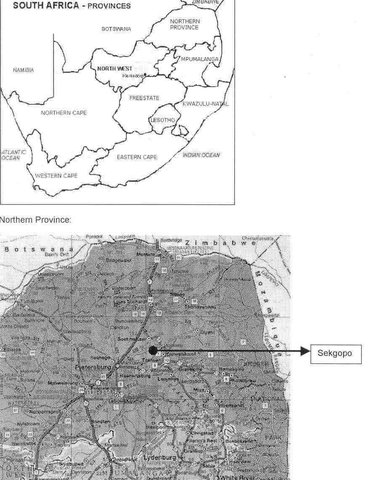
Government funded demonstrations [南非]
Government funded restoration demonstration site to restore degraded land - by community participation. Community becoming the key sake holders - Capacity building.
- 编制者: Klaus Kellner
2. SLM技术的说明
2.1 技术简介
技术定义:
Revegetation of old, degraded land. Restoring area to increase grazing capacity and production.
2.2 技术的详细说明
说明:
Vegetative (revegetation/re-seeding) improvement for an increase in grass production and to increase the grazing capacity of the area.
The rural community identified an old degraded land - the area was fenced to exclude grazing by large herbivores. The woody species that encroached the area were debushed. Area was ploughed and re-seeded with palatable, climax, big tufted, perennial grass species. Some plots were covered with twigs (bush packing). The area was protected from grazing. Monitoring of vegetation was done at the end of the growing season.
2.3 技术照片
2.5 已应用该技术的、本评估所涵盖的国家/地区/地点
国家:
南非
区域/州/省:
Limpopo
有关地点的进一步说明:
Pietersburg
具体说明该技术的分布:
- 均匀地分布在一个区域
如果技术均匀分布在一个区域,则指定覆盖的区域(单位为平方千米):
1.0
如果不知道精确的区域,请注明大致覆盖的区域:
- 0.1-1 平方千米
注释:
Total area covered by the SLM Technology is 1 km2.
Old land near rural villages, Sekgopo, 50 km north of Pietersburg in the Northern Province of South Africa. Old land degraded.
Map
×2.6 实施日期
如果不知道确切的年份,请说明大概的日期:
- 不到10年前(最近)
2.7 技术介绍
详细说明该技术是如何引入的:
- 在实验/研究期间
注释(项目类型等):
Restore degraded areas
3. SLM技术的分类
3.1 该技术的主要目的
- 减少、预防、恢复土地退化
3.2 应用该技术的当前土地利用类型

牧场
粗放式放牧:
- 半游牧畜牧业
注释:
Main animal species and products: Communal land, some commercial
Major land use problems (compiler’s opinion): Overgrazing and loss of palatable, climax vegetation.
Major land use problems (land users’ perception): No grazing for animals; bush/woody encroachment.
Semi-nomadism / pastoralism: Communal land, some commercial
Grazingland comments: Large herds of livestock - but not owned individually - communally managed.
Land users owned few cattle/small stock in herd.
Type of grazing system comments: Large herds of livestock - but not owned individually - communally managed.
Land users owned few cattle/small stock in herd.
Number of growing seasons per year: 1
Longest growing period in days: 210; Longest growing period from month to month: Oct - Apr
3.4 供水
该技术所应用土地的供水:
- 雨养
3.5 该技术所属的SLM组
- 区域封闭(停止使用,支持恢复)
3.6 包含该技术的可持续土地管理措施

植物措施
- V2:草和多年生草本植物
注释:
Main measures: vegetative measures
Type of vegetative measures: aligned: -graded strips *<sup>3</sup>
3.7 该技术强调的主要土地退化类型

土壤水蚀
- Wt:表土流失/地表侵蚀
- Wg:冲沟侵蚀/沟蚀

化学性土壤退化
- Cn:肥力下降和有机质含量下降(非侵蚀所致)

水质恶化
- Ha:干旱化
注释:
Secondary types of degradation addressed: Wt: loss of topsoil / surface erosion, Wg: gully erosion / gullying, Ha: aridification
Main causes of degradation: over-exploitation of vegetation for domestic use, overgrazing, education, access to knowledge and support services (Lack of knowledge)
Secondary causes of degradation: other human induced causes (specify) (Cropping on marginal lands), labour availability (Lack of labour)
3.8 防止、减少或恢复土地退化
具体数量名该技术与土地退化有关的目标:
- 减少土地退化
- 修复/恢复严重退化的土地
注释:
Secondary goals: prevention of land degradation
4. 技术规范、实施活动、投入和成本
4.1 该技术的技术图纸
技术规范(与技术图纸相关):
Experimental plot
Location: Sekgopo. Northern Province
Technical knowledge required for field staff / advisors: moderate
Technical knowledge required for land users: moderate
Main technical functions: control of raindrop splash, increase in organic matter, increase in soil fertility, improvement of ground cover
Secondary technical functions: control of dispersed runoff: retain / trap, control of dispersed runoff: impede / retard, control of concentrated runoff: impede / retard, reduction of slope angle, increase of surface roughness, increase of infiltration, increase / maintain water stored in soil, water harvesting / increase water supply, water spreading, sediment retention / trapping, sediment harvesting, reduction in wind speed, improvement of soil structure
Aligned: -graded strips
Vegetative material: G : grass
Vertical interval between rows / strips / blocks (m): 0.00
Spacing between rows / strips / blocks (m): 1.00
Vertical interval within rows / strips / blocks (m): 1.00
Width within rows / strips / blocks (m): 0.30
Grass species: 5 Perennial, climax grass types
Slope (which determines the spacing indicated above): 4.00%
作者:
Klaus Kellner
4.2 有关投入和成本计算的一般信息
具体说明成本计算所用货币:
- 美元
注明雇用劳工的每日平均工资成本:
3.60
4.3 技术建立活动
| 活动 | 时间(季度) | |
|---|---|---|
| 1. | Ripping | At start of technology and beginning of rainy season |
| 2. | Oversowing | At start of technology and beginning of rainy season |
| 3. | Bush packing | At start of technology and beginning of rainy season |
4.4 技术建立所需要的费用和投入
| 对投入进行具体说明 | 单位 | 数量 | 单位成本 | 每项投入的总成本 | 土地使用者承担的成本% | |
|---|---|---|---|---|---|---|
| 劳动力 | Bush packing, sowing and ripping | persons/day/ha | 172.0 | 3.2 | 550.4 | 10.0 |
| 设备 | Machine use | ha | 1.0 | 30.0 | 30.0 | |
| 设备 | Tools | ha | 1.0 | 20.0 | 20.0 | |
| 植物材料 | Seeds | ha | 1.0 | 150.0 | 150.0 | |
| 施工材料 | Fencing | ha | 1.0 | 1100.0 | 1100.0 | |
| 技术建立所需总成本 | 1850.4 | |||||
| 技术建立总成本,美元 | 1850.4 | |||||
注释:
Duration of establishment phase: 12 month(s)
4.5 维护/经常性活动
| 活动 | 时间/频率 | |
|---|---|---|
| 1. | No maintenance | |
| 2. | Fencing in tact | /Once a year |
4.6 维护/经常性活动所需要的费用和投入(每年)
| 对投入进行具体说明 | 单位 | 数量 | 单位成本 | 每项投入的总成本 | 土地使用者承担的成本% | |
|---|---|---|---|---|---|---|
| 劳动力 | Maintain fence | persons/day/ha | 62.5 | 3.2 | 200.0 | 10.0 |
| 施工材料 | Fence | ha | 1.0 | 50.0 | 50.0 | |
| 技术维护所需总成本 | 250.0 | |||||
| 技术维护总成本,美元 | 250.0 | |||||
注释:
Seeds purchasing, Erection of restoration demonstration site.
4.7 影响成本的最重要因素
描述影响成本的最决定性因素:
Labour, fencing and maintenance. Maintenance costs include man days and travelling for vegetation monitoring and sampling.
5. 自然和人文环境
5.1 气候
年降雨量
- < 250毫米
- 251-500毫米
- 501-750毫米
- 751-1,000毫米
- 1,001-1,500毫米
- 1,501-2,000毫米
- 2,001-3,000毫米
- 3,001-4,000毫米
- > 4,000毫米
指定年平均降雨量(若已知),单位为mm:
450.00
农业气候带
- 半干旱
5.2 地形
平均坡度:
- 水平(0-2%)
- 缓降(3-5%)
- 平缓(6-10%)
- 滚坡(11-15%)
- 崎岖(16-30%)
- 陡峭(31-60%)
- 非常陡峭(>60%)
地形:
- 高原/平原
- 山脊
- 山坡
- 山地斜坡
- 麓坡
- 谷底
垂直分布带:
- 0-100 m a.s.l.
- 101-500 m a.s.l.
- 501-1,000 m a.s.l.
- 1,001-1,500 m a.s.l.
- 1,501-2,000 m a.s.l.
- 2,001-2,500 m a.s.l.
- 2,501-3,000 m a.s.l.
- 3,001-4,000 m a.s.l.
- > 4,000 m a.s.l.
5.3 土壤
平均土层深度:
- 非常浅(0-20厘米)
- 浅(21-50厘米)
- 中等深度(51-80厘米)
- 深(81-120厘米)
- 非常深(> 120厘米)
土壤质地(表土):
- 中粒(壤土、粉土)
表土有机质:
- 低(<1%)
如有可能,附上完整的土壤描述或具体说明可用的信息,例如土壤类型、土壤酸碱度、阳离子交换能力、氮、盐度等。:
Soil fertility is low
Soil drainage / infiltration is medium
Soil water storage capacity is low
5.6 应用该技术的土地使用者的特征
生产系统的市场定位:
- 生计(自给)
非农收入:
- > 收入的50%
相对财富水平:
- 贫瘠
说明土地使用者的其他有关特征:
Population density: 50-100 persons/km2
Annual population growth: 3% - 4%
100% of the land users are poor and own 100% of the land (Communal land).
Off-farm income specification: Old age pensions (state pensions), Mine workers (family members working in Cities).
5.7 应用该技术的土地使用者使用的平均土地面积
- < 0.5 公顷
- 0.5-1 公顷
- 1-2 公顷
- 2-5公顷
- 5-15公顷
- 15-50公顷
- 50-100公顷
- 100-500公顷
- 500-1,000公顷
- 1,000-10,000公顷
- > 10,000公顷
注释:
Communal land
5.8 土地所有权、土地使用权和水使用权
土地所有权:
- 社区/村庄
土地使用权:
- 社区(有组织)
6. 影响和结论性说明
6.1 该技术的现场影响
社会经济效应
生产
作物生产
饲料生产
注释/具体说明:
Grazing increase
饲料质量
注释/具体说明:
Grazing increase
收入和成本
农业收入
工作量
注释/具体说明:
Only few people could be employed - more would have liked to earn money
社会文化影响
社区机构
国家机构
SLM/土地退化知识
注释/具体说明:
Capacity building awareness
冲突缓解
注释/具体说明:
Farmers and land users did not all agree to the SWC technology
job - creation
生态影响
水循环/径流
多余水的排放
土壤
土壤水分
土壤覆盖层
土壤流失
SLM之前的数量:
2
SLM之后的数量:
0
减少气候和灾害风险
风速
其它生态影响
soil fertility
biodiversity
6.2 该技术的场外影响已经显现
旱季稳定可靠的水流
下游洪水
下游淤积
地下水/河流污染
风力搬运沉积物
6.4 成本效益分析
技术收益与技术建立成本相比如何(从土地使用者的角度看)?
短期回报:
轻度消极
长期回报:
积极
技术收益与技术维护成本/经常性成本相比如何(从土地使用者的角度看)?
短期回报:
轻度消极
长期回报:
积极
6.5 技术采用
- > 50%
如若可行,进行量化(住户数量和/或覆盖面积):
11 households, covering 100 percent of the stated area
在所有采用这项技术的人当中,有多少人是自发的,即未获得任何物质奖励/付款?:
- 0-10%
注释:
10 land user families have adopted the Technology with external material support
Comments on acceptance with external material support: estimates
1 land user families have adopted the Technology without any external material support
Comments on spontaneous adoption: estimates
There is a moderate trend towards spontaneous adoption of the Technology
Comments on adoption trend: With proper awareness and participation, adoption and implementation rate will be higher.
7. 参考和链接
7.1 信息的方法/来源
链接和模块
全部展开 全部收起链接

Government funded demonstrations [南非]
Government funded restoration demonstration site to restore degraded land - by community participation. Community becoming the key sake holders - Capacity building.
- 编制者: Klaus Kellner
模块
无模块


